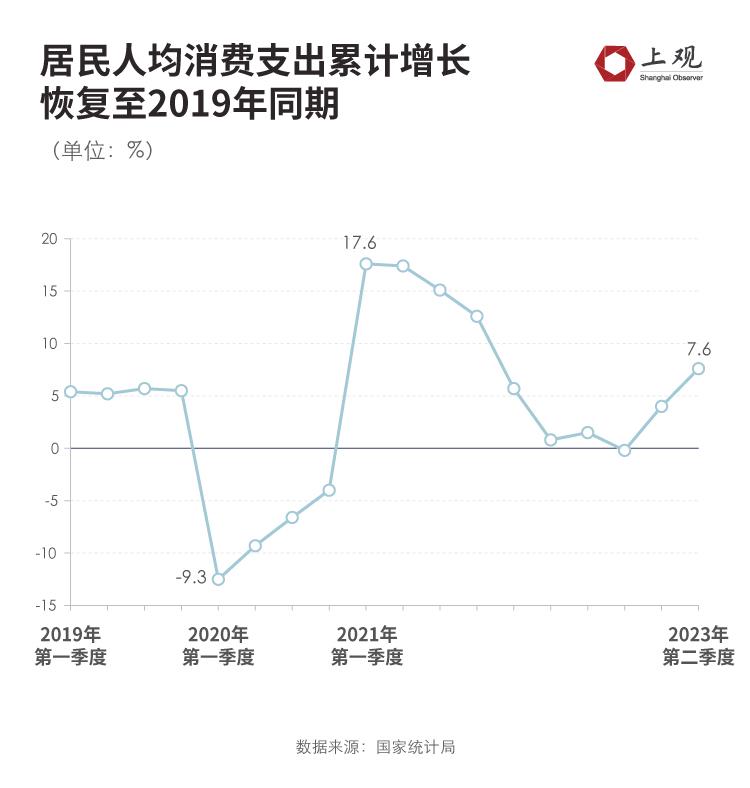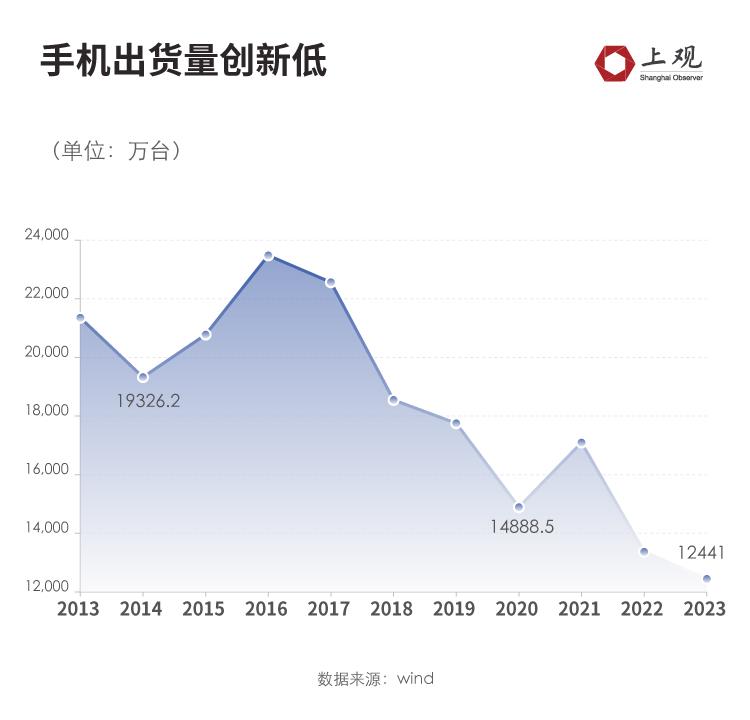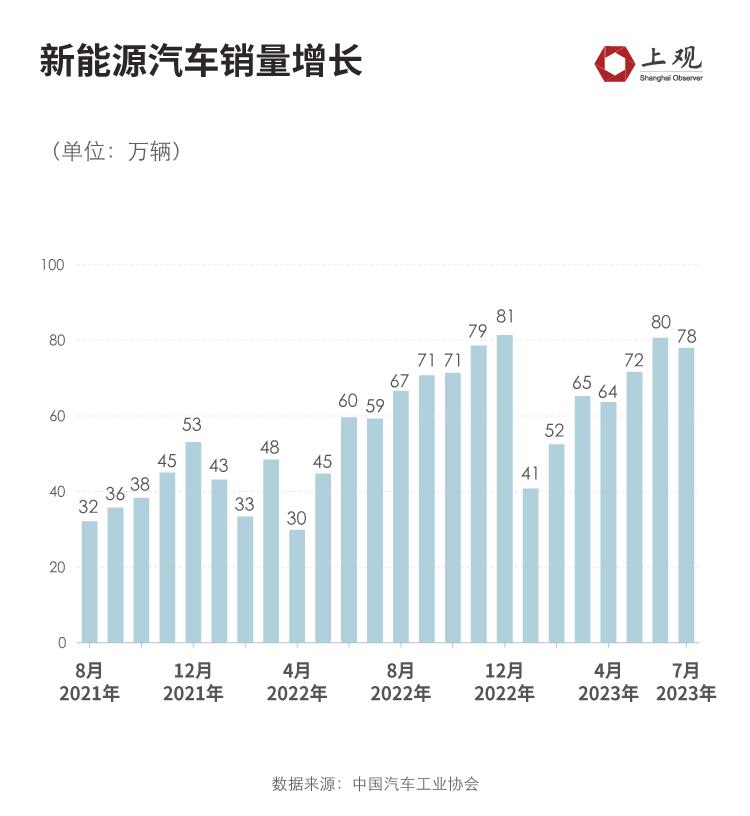Chinese’s consumption desire has changed, and "revenge consumption" is concentrated in these areas.
"I haven’t billed for more than a week. I have been in this business for more than 20 years. This year is a career bottleneck."
Sister Liu is a salesman in a clothing store on Weihai Road, Jing ‘an District. She wondered, everyone is traveling in revenge, eating and drinking. Why don’t they just love buying clothes?
Consumption growth returns to 2019
Judging from the household consumption data released by the National Bureau of Statistics, in the first and second quarters of this year, the year-on-year growth rate of per capita consumption expenditure maintained a positive growth, and the cumulative growth rate in the second quarter reached 7.6%, the highest in the past year.
If we set aside the low base of last year, compared with the same period in 2021, the compound growth rate of per capita consumption accumulated expenditure in the second quarter of this year was 5.38%.exceed2019Year-on-year growth in the second quarter of, and2019The average growth rate of the whole year was similar.
That is to say,The overall consumption situation has basically recovered to2019Year-on-year level.

However, judging from the growth trend of CPI,The consumption desire of residents is on the decline.
CPI is the consumer price index, and the falling prices reflect the declining demand, sluggish consumption and low desire of residents.
According to the data of the Bureau of Statistics, since the beginning of this year, the simultaneous growth of CPI has been limited, and the growth rate has shown a downward trend. In July, it was even negative, down 0.3% year-on-year.
Eat too much and wear less.
If the overall consumption situation has been restored to 2019, then why is the business of Sister Liu’s clothing store not satisfactory?
Because the consumption structure of residents has changed—Eat more, wear less and use less.
Comparing the consumption structure of residents in the first half of this year and the first half of 2019, it is found that the proportion of food, tobacco and alcohol expenditure has increased the most, reaching 2.1%, and the proportion of other consumption has decreased except medical care.
Among them,Clothes are the most reduced, accounting for a decrease of 1.1%.

In the words of Wang Cheng (a pseudonym),Consumption degradation is the theme of this year. If the "exquisite life" can be reduced, it will be reduced. The main theme is "spend a little money and buy big happiness".
Wang Cheng, a financial risk manager, shares her daily expenses in the little red book. Her head is also straightforward, a piggy bank with the characters "engage in money".
According to Wang Cheng’s account, her spending on clothing and skin care has been greatly reduced this year. Originally, she planned to spend 5,000 yuan and 2,000 yuan respectively, but until August, she only spent less than 1,400 yuan on clothing and almost zero on skin care, only 16 yuan.
"The basic principle is one in one, and the auxiliary principle is not to buy as much as possible." Wang Cheng said. After all, clothes can be worn as long as they are not worn, and it is a little bit economical.
Tourism consumption exceeds budget
However, due to three years’ restraint, traveling and vacationing can’t be saved, which has become the only project that Wang Cheng has exceeded the budget this year. In July, Wang Cheng went to Sanya for a holiday and spent more than 10,000 yuan.
Wang Cheng’s consumption mentality is very representative, namely"The tourism market is booming, and non-essential expenses have dropped sharply".
In the first half of this year, the number of domestic tourists reached 2.384 billion, close to the whole year of 2022, with a year-on-year increase of 63.9%.
The per capita expenditure on tourism has also increased, with an increase of 19.3% compared with 2022, which has also exceeded the per capita expenditure in 2019. Among them, the year-on-year increase of per capita domestic tourism expenditure of urban residents reached 21.64%.

Don’t change your mobile phone if you can.
On the other hand, non-necessities such as mobile phones encounter the same "bleak" dilemma as "clothing"-As long as it still works, you don’t have to change it..
According to statistics, in the first half of this year, China’s smartphone shipments were the lowest in the past decade.
For example, Xiaomi’s revenue in the first quarter of this year fell by 18.9% year-on-year, and the revenue of mobile phone business fell even more, reaching 30.8%.

The property market dragged down the consumption of household appliances and furniture.
It is not only non-durable small commodities such as clothes and mobile phones that cannot be sold, but also houses are difficult to sell.
According to statistics, as of July, the transaction volume of commercial housing in 30 large and medium-sized cities in China decreased by 3.98% year-on-year. Except for the first-tier cities, which increased by 15.54% year-on-year, the growth rate of second-and third-tier cities was negative, and the second-tier cities decreased more, with a decrease of 13.22%.

The house is difficult to sell, which is related to related industries and commodities.
According to the data released by the National Bureau of Statistics, from January to July, the retail sales of consumer goods above designated size showed a positive growth trend, with a year-on-year increase of 7.1% and a compound growth of 5.6%.
But among the 18 categories of goods,The compound growth rate of three kinds of commodities is negative, including household appliances, furniture, building and decoration materials.
Among them, building and decoration materials are the most affected.
As of July, the current value of retail sales of such goods was 91.6 billion yuan, down 11.6% from last year, and the compound growth rate dropped by 6.2%.
Corresponding to specific enterprises, such as Red Star Macalline, which specializes in furniture, it is estimated that the net profit returned to the mother in the first half of this year will decrease by 860 million yuan to 890 million yuan, down by 83.9% to 96.8%.

Car price war
However,Cars that are also big-ticket goods still have a certain market for new energy vehicles, and major brands have launched "price wars" one after another, and then superimposed the preferential policies introduced by the central and local governments, the sales volume is still rising.
According to the data of China Association of Automobile Manufacturers, as of July, the sales of new energy vehicles exceeded 4.52 million, a year-on-year increase of 42.1%.

On the whole, in the current consumer market, "retaliatory consumption" appears in markets such as tourism and movies, and there is still much room for improvement in domestic demand, especially in real estate, and there is still a structural demand shortage in low-tier cities.
In this regard, Professor Liu Qiao from Guanghua School of Management, Peking University suggested that the problem of declining balance sheet quality of residents and enterprises caused by the epidemic can be solved through active fiscal policies, and investment in node industries can be vigorously promoted.
On the consumer side, direct transfer payments can be made to residents by issuing cash and coupons, which not only enhances individual families’ willingness and ability to consume, but also effectively supports market players to promote a virtuous circle in the market.